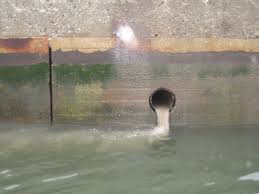Why We Should Care About CSOs
February 5, 2019
CSOs are a major problem for twenty-one communities in New Jersey, yet very few New Jerseyans even know what a CSO is. In simplest terms, a CSO is a combined sewer outfall that exists as a result of a municipality having a combined sanitary and stormwater sewer system. Typically, towns have one sewer system dedicated to sanitary wastewater (i.e., the water that comes from household toilets, showers, or washing machines) and a separate system of pipes to move stormwater collected from the city’s storm drains. The sanitary waste pipes lead to a wastewater treatment plant to be sanitized before reaching nearby waterways, while the storm drains flow directly to our waterways without treatment (which is an issue in itself).
In a CSO community, these two sets of pipes are not completely separated. As a result, when a major rain occurs and people continue to use their household water at normal rates, the two sets of pipes overflow into one and wash out into a nearby waterbody, much of the water bypassing the wastewater treatment plant. The end result is in the wake of a heavy rainfall, untreated sewage flows out into the waterways we use to boat, kayak, fish, and sometimes even swim.
The good news is that the NJ Department of Environmental Protection has been working on correcting the state’s CSO problem. The bad news is that it took a lawsuit to get the process going that will take another twenty to thirty years to fix CSOs.
Through an NJDEP-issued permit, CSO municipalities are required to explore the separation of systems and other various methods of eliminating CSOs. Since total separation of sewer pipes is an extremely expensive proposition (billions of dollars expensive), most municipalities simply cannot afford that option. There is more than one way to eliminate CSOs, and this is where we all come in as solutions to a very complex problem. Projects like community rain gardens, rain barrels on home drainpipes, and the reduction of impervious surfaces (replace concrete with grass or asphalt with pavers) can all contribute to an overall reduction of CSOs. By reducing the amount of water entering the system, we can effect a practical and less costly reduction of the burden on the sewer system.
Another serious point on CSOs comes down to money. It is going to cost us all in one way or another as our cities work on the CSO problem. We may see an increase in taxes to help pay for maintenance of infrastructure, a stormwater utility fee added to cover costs of added infrastructure, or an increase in our rents to account for water reduction measures taken by landlords or building owners. If we do nothing now to correct the CSO problem, the costs will be more personal: higher insurance to cover flooding, health impacts from contact with contaminated water, or the cost of recovery and repairs to our property from flooding issues.
CSOs are not going away any time soon, but we can definitely reduce their impact right now by taking the right steps towards reducing the amount of water that enters the sewer system through creative and inexpensive green infrastructure projects. For some ideas on what you can do visit the EPA’s webpage on Green Infrastructure here.
Why We Should Care About CSOs
